Reflective Analysis of the Internal Business Environment: ASDA
VerifiedAdded on 2023/01/16
|8
|2574
|92
Report
AI Summary
This report provides a comprehensive analysis of ASDA's internal business environment, focusing on the application of Porter's Value Chain Analysis. The introduction establishes the context of the business environment and introduces ASDA, a major UK supermarket retailer. The main body delves into the Value Chain Analysis, explaining its components and how it helps in assessing the internal workings of a business. The report then applies this analysis to ASDA, examining its primary activities like inbound and outbound logistics, marketing, and customer service, as well as secondary activities such as procurement and human resource management. The analysis highlights the strengths and weaknesses within ASDA's operations, particularly in areas like customer service and technological development. The reflection section discusses the benefits of using Value Chain Analysis, such as improved understanding of business operations, customer-centricity, and identification of areas needing improvement. The conclusion summarizes the key findings, emphasizing the importance of the Value Chain Analysis in understanding ASDA's internal environment and its impact on value creation for customers.
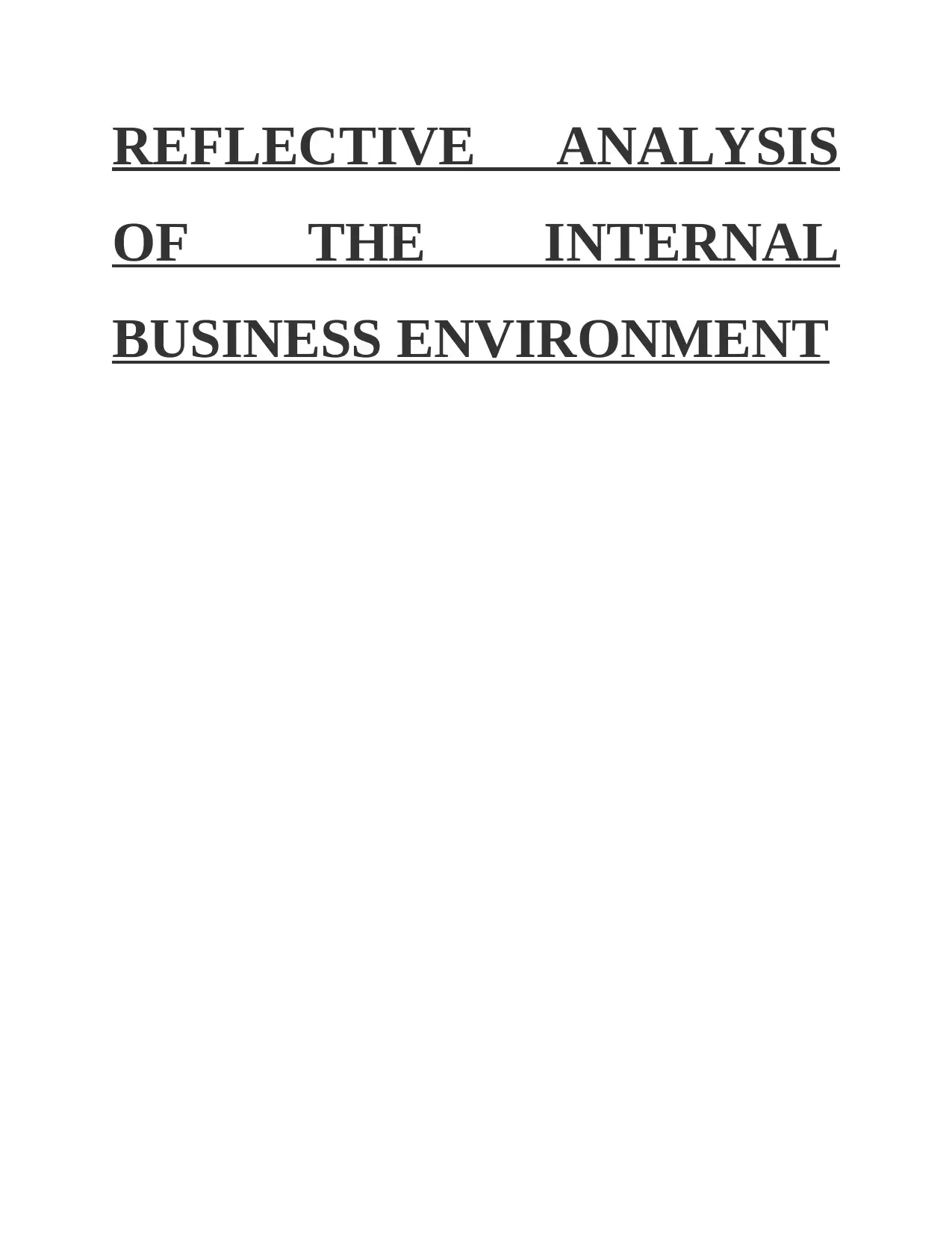
REFLECTIVE ANALYSIS
OF THE INTERNAL
BUSINESS ENVIRONMENT
OF THE INTERNAL
BUSINESS ENVIRONMENT
Paraphrase This Document
Need a fresh take? Get an instant paraphrase of this document with our AI Paraphraser
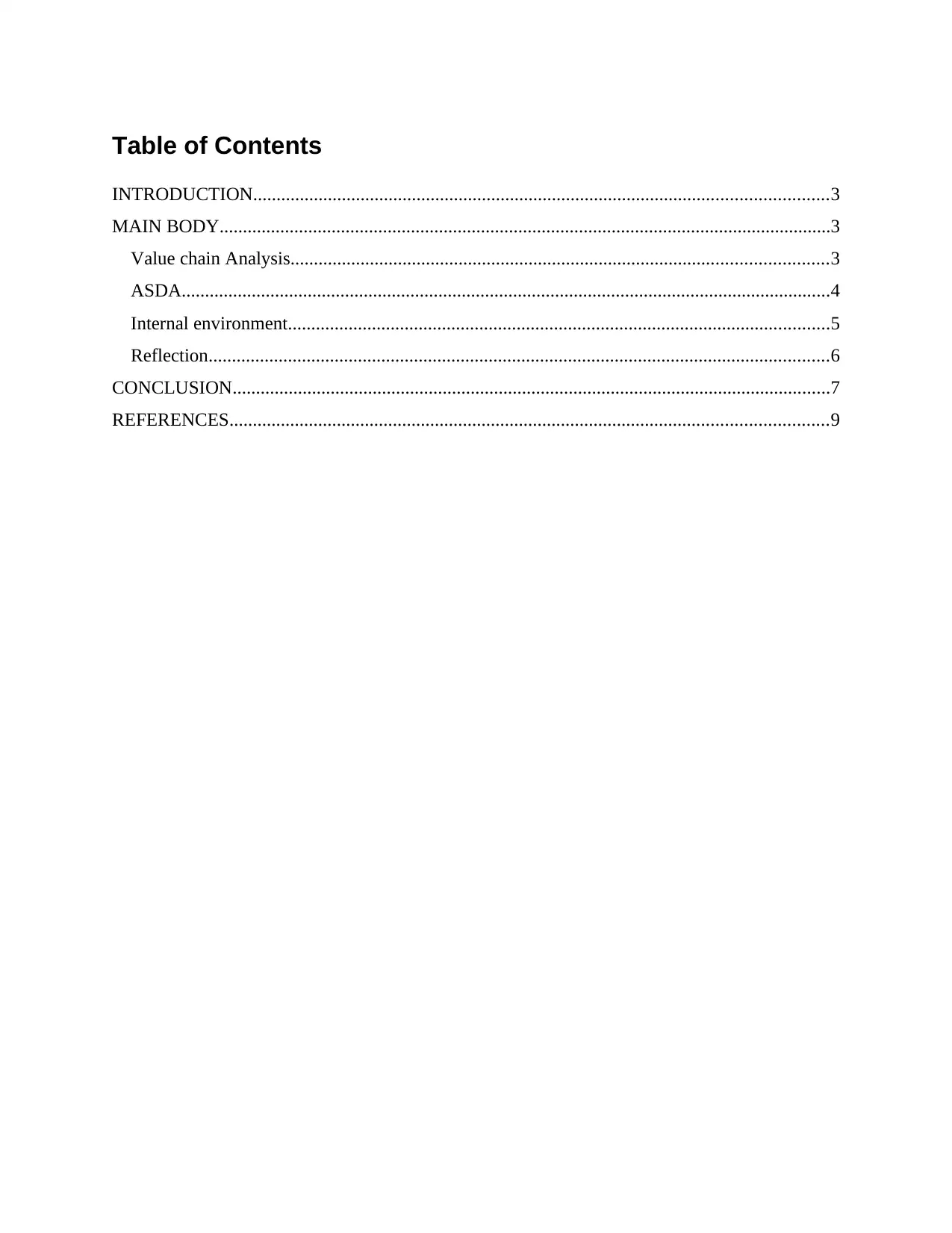
Table of Contents
INTRODUCTION...........................................................................................................................3
MAIN BODY...................................................................................................................................3
Value chain Analysis...................................................................................................................3
ASDA...........................................................................................................................................4
Internal environment....................................................................................................................5
Reflection.....................................................................................................................................6
CONCLUSION................................................................................................................................7
REFERENCES................................................................................................................................9
INTRODUCTION...........................................................................................................................3
MAIN BODY...................................................................................................................................3
Value chain Analysis...................................................................................................................3
ASDA...........................................................................................................................................4
Internal environment....................................................................................................................5
Reflection.....................................................................................................................................6
CONCLUSION................................................................................................................................7
REFERENCES................................................................................................................................9
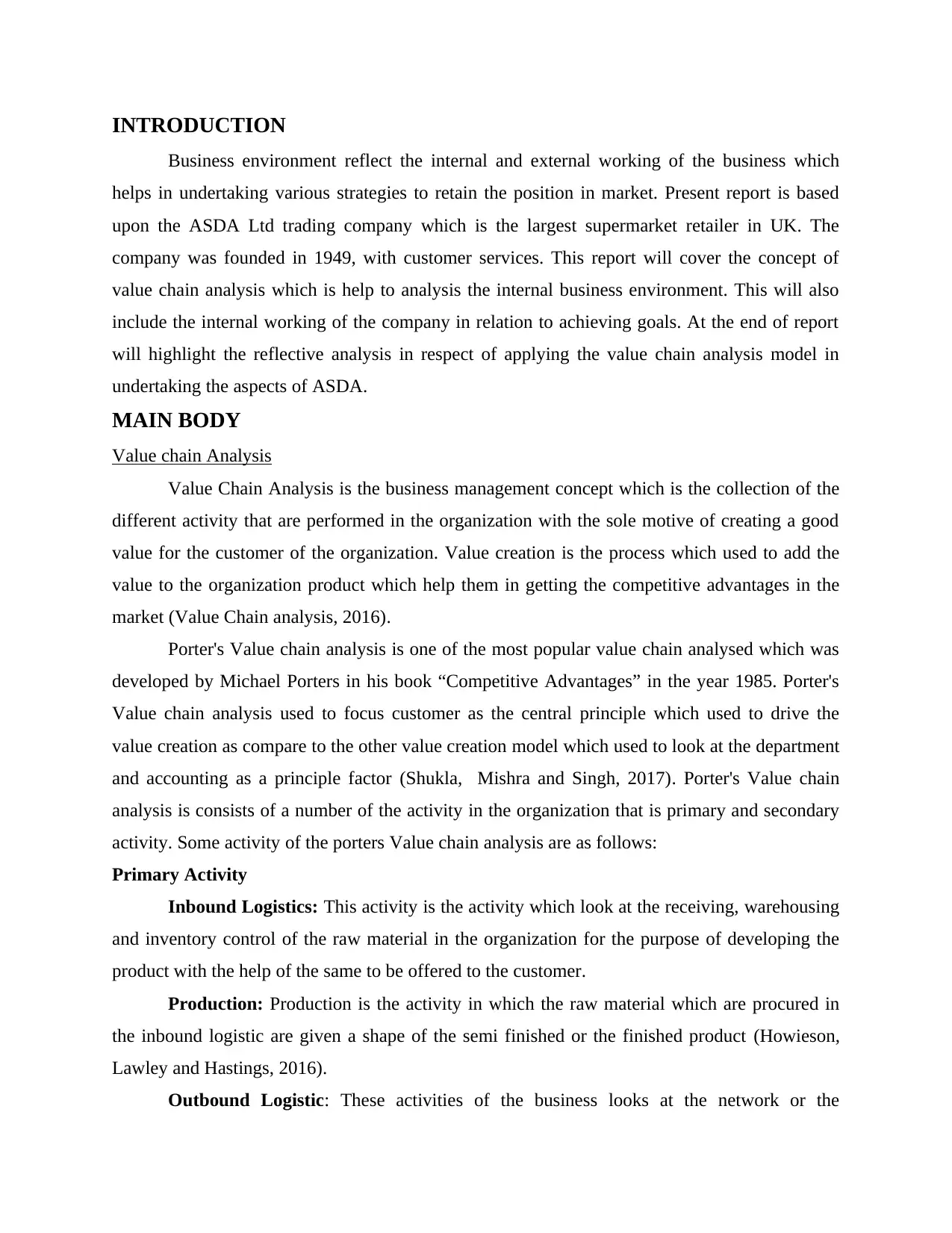
INTRODUCTION
Business environment reflect the internal and external working of the business which
helps in undertaking various strategies to retain the position in market. Present report is based
upon the ASDA Ltd trading company which is the largest supermarket retailer in UK. The
company was founded in 1949, with customer services. This report will cover the concept of
value chain analysis which is help to analysis the internal business environment. This will also
include the internal working of the company in relation to achieving goals. At the end of report
will highlight the reflective analysis in respect of applying the value chain analysis model in
undertaking the aspects of ASDA.
MAIN BODY
Value chain Analysis
Value Chain Analysis is the business management concept which is the collection of the
different activity that are performed in the organization with the sole motive of creating a good
value for the customer of the organization. Value creation is the process which used to add the
value to the organization product which help them in getting the competitive advantages in the
market (Value Chain analysis, 2016).
Porter's Value chain analysis is one of the most popular value chain analysed which was
developed by Michael Porters in his book “Competitive Advantages” in the year 1985. Porter's
Value chain analysis used to focus customer as the central principle which used to drive the
value creation as compare to the other value creation model which used to look at the department
and accounting as a principle factor (Shukla, Mishra and Singh, 2017). Porter's Value chain
analysis is consists of a number of the activity in the organization that is primary and secondary
activity. Some activity of the porters Value chain analysis are as follows:
Primary Activity
Inbound Logistics: This activity is the activity which look at the receiving, warehousing
and inventory control of the raw material in the organization for the purpose of developing the
product with the help of the same to be offered to the customer.
Production: Production is the activity in which the raw material which are procured in
the inbound logistic are given a shape of the semi finished or the finished product (Howieson,
Lawley and Hastings, 2016).
Outbound Logistic: These activities of the business looks at the network or the
Business environment reflect the internal and external working of the business which
helps in undertaking various strategies to retain the position in market. Present report is based
upon the ASDA Ltd trading company which is the largest supermarket retailer in UK. The
company was founded in 1949, with customer services. This report will cover the concept of
value chain analysis which is help to analysis the internal business environment. This will also
include the internal working of the company in relation to achieving goals. At the end of report
will highlight the reflective analysis in respect of applying the value chain analysis model in
undertaking the aspects of ASDA.
MAIN BODY
Value chain Analysis
Value Chain Analysis is the business management concept which is the collection of the
different activity that are performed in the organization with the sole motive of creating a good
value for the customer of the organization. Value creation is the process which used to add the
value to the organization product which help them in getting the competitive advantages in the
market (Value Chain analysis, 2016).
Porter's Value chain analysis is one of the most popular value chain analysed which was
developed by Michael Porters in his book “Competitive Advantages” in the year 1985. Porter's
Value chain analysis used to focus customer as the central principle which used to drive the
value creation as compare to the other value creation model which used to look at the department
and accounting as a principle factor (Shukla, Mishra and Singh, 2017). Porter's Value chain
analysis is consists of a number of the activity in the organization that is primary and secondary
activity. Some activity of the porters Value chain analysis are as follows:
Primary Activity
Inbound Logistics: This activity is the activity which look at the receiving, warehousing
and inventory control of the raw material in the organization for the purpose of developing the
product with the help of the same to be offered to the customer.
Production: Production is the activity in which the raw material which are procured in
the inbound logistic are given a shape of the semi finished or the finished product (Howieson,
Lawley and Hastings, 2016).
Outbound Logistic: These activities of the business looks at the network or the
⊘ This is a preview!⊘
Do you want full access?
Subscribe today to unlock all pages.

Trusted by 1+ million students worldwide
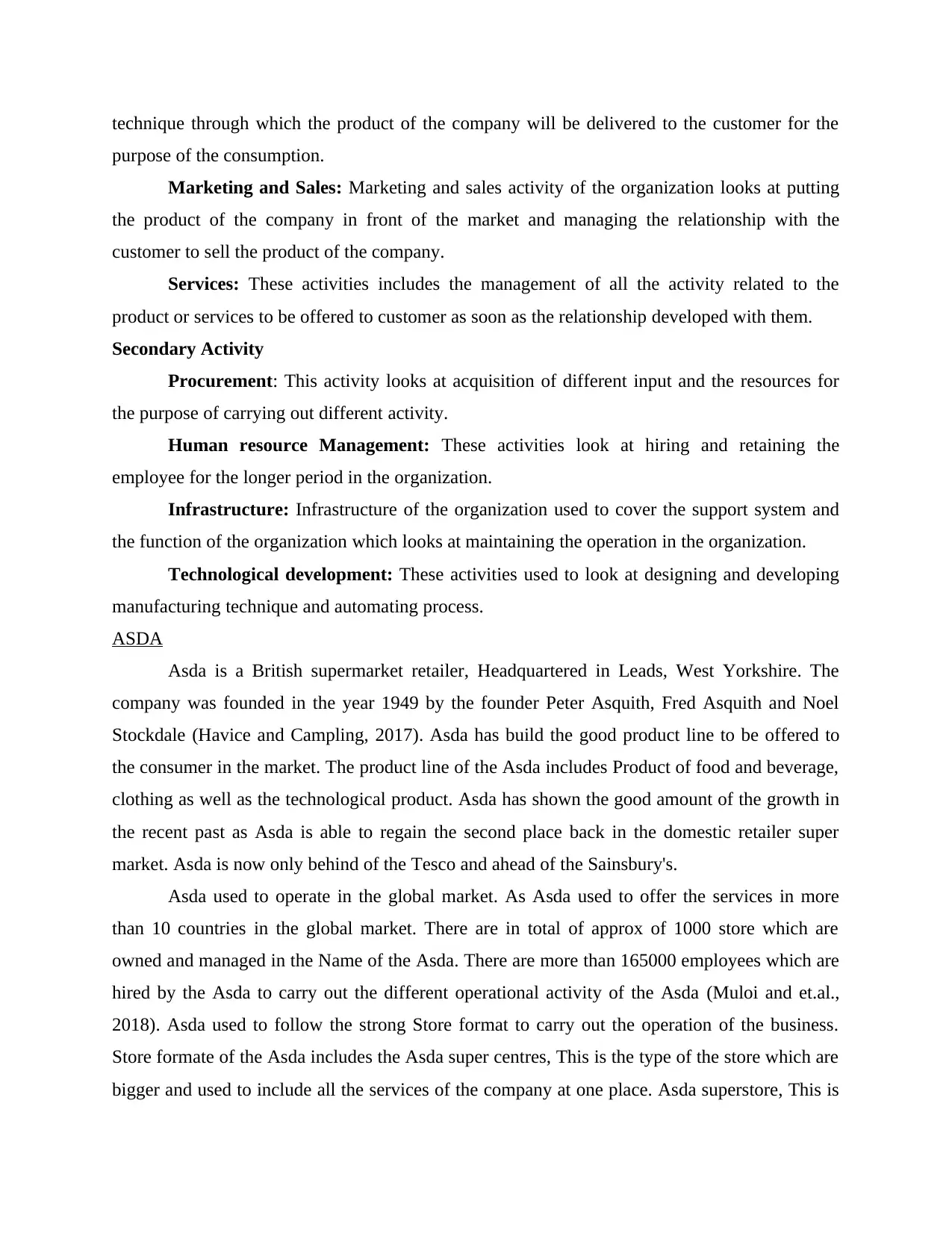
technique through which the product of the company will be delivered to the customer for the
purpose of the consumption.
Marketing and Sales: Marketing and sales activity of the organization looks at putting
the product of the company in front of the market and managing the relationship with the
customer to sell the product of the company.
Services: These activities includes the management of all the activity related to the
product or services to be offered to customer as soon as the relationship developed with them.
Secondary Activity
Procurement: This activity looks at acquisition of different input and the resources for
the purpose of carrying out different activity.
Human resource Management: These activities look at hiring and retaining the
employee for the longer period in the organization.
Infrastructure: Infrastructure of the organization used to cover the support system and
the function of the organization which looks at maintaining the operation in the organization.
Technological development: These activities used to look at designing and developing
manufacturing technique and automating process.
ASDA
Asda is a British supermarket retailer, Headquartered in Leads, West Yorkshire. The
company was founded in the year 1949 by the founder Peter Asquith, Fred Asquith and Noel
Stockdale (Havice and Campling, 2017). Asda has build the good product line to be offered to
the consumer in the market. The product line of the Asda includes Product of food and beverage,
clothing as well as the technological product. Asda has shown the good amount of the growth in
the recent past as Asda is able to regain the second place back in the domestic retailer super
market. Asda is now only behind of the Tesco and ahead of the Sainsbury's.
Asda used to operate in the global market. As Asda used to offer the services in more
than 10 countries in the global market. There are in total of approx of 1000 store which are
owned and managed in the Name of the Asda. There are more than 165000 employees which are
hired by the Asda to carry out the different operational activity of the Asda (Muloi and et.al.,
2018). Asda used to follow the strong Store format to carry out the operation of the business.
Store formate of the Asda includes the Asda super centres, This is the type of the store which are
bigger and used to include all the services of the company at one place. Asda superstore, This is
purpose of the consumption.
Marketing and Sales: Marketing and sales activity of the organization looks at putting
the product of the company in front of the market and managing the relationship with the
customer to sell the product of the company.
Services: These activities includes the management of all the activity related to the
product or services to be offered to customer as soon as the relationship developed with them.
Secondary Activity
Procurement: This activity looks at acquisition of different input and the resources for
the purpose of carrying out different activity.
Human resource Management: These activities look at hiring and retaining the
employee for the longer period in the organization.
Infrastructure: Infrastructure of the organization used to cover the support system and
the function of the organization which looks at maintaining the operation in the organization.
Technological development: These activities used to look at designing and developing
manufacturing technique and automating process.
ASDA
Asda is a British supermarket retailer, Headquartered in Leads, West Yorkshire. The
company was founded in the year 1949 by the founder Peter Asquith, Fred Asquith and Noel
Stockdale (Havice and Campling, 2017). Asda has build the good product line to be offered to
the consumer in the market. The product line of the Asda includes Product of food and beverage,
clothing as well as the technological product. Asda has shown the good amount of the growth in
the recent past as Asda is able to regain the second place back in the domestic retailer super
market. Asda is now only behind of the Tesco and ahead of the Sainsbury's.
Asda used to operate in the global market. As Asda used to offer the services in more
than 10 countries in the global market. There are in total of approx of 1000 store which are
owned and managed in the Name of the Asda. There are more than 165000 employees which are
hired by the Asda to carry out the different operational activity of the Asda (Muloi and et.al.,
2018). Asda used to follow the strong Store format to carry out the operation of the business.
Store formate of the Asda includes the Asda super centres, This is the type of the store which are
bigger and used to include all the services of the company at one place. Asda superstore, This is
Paraphrase This Document
Need a fresh take? Get an instant paraphrase of this document with our AI Paraphraser
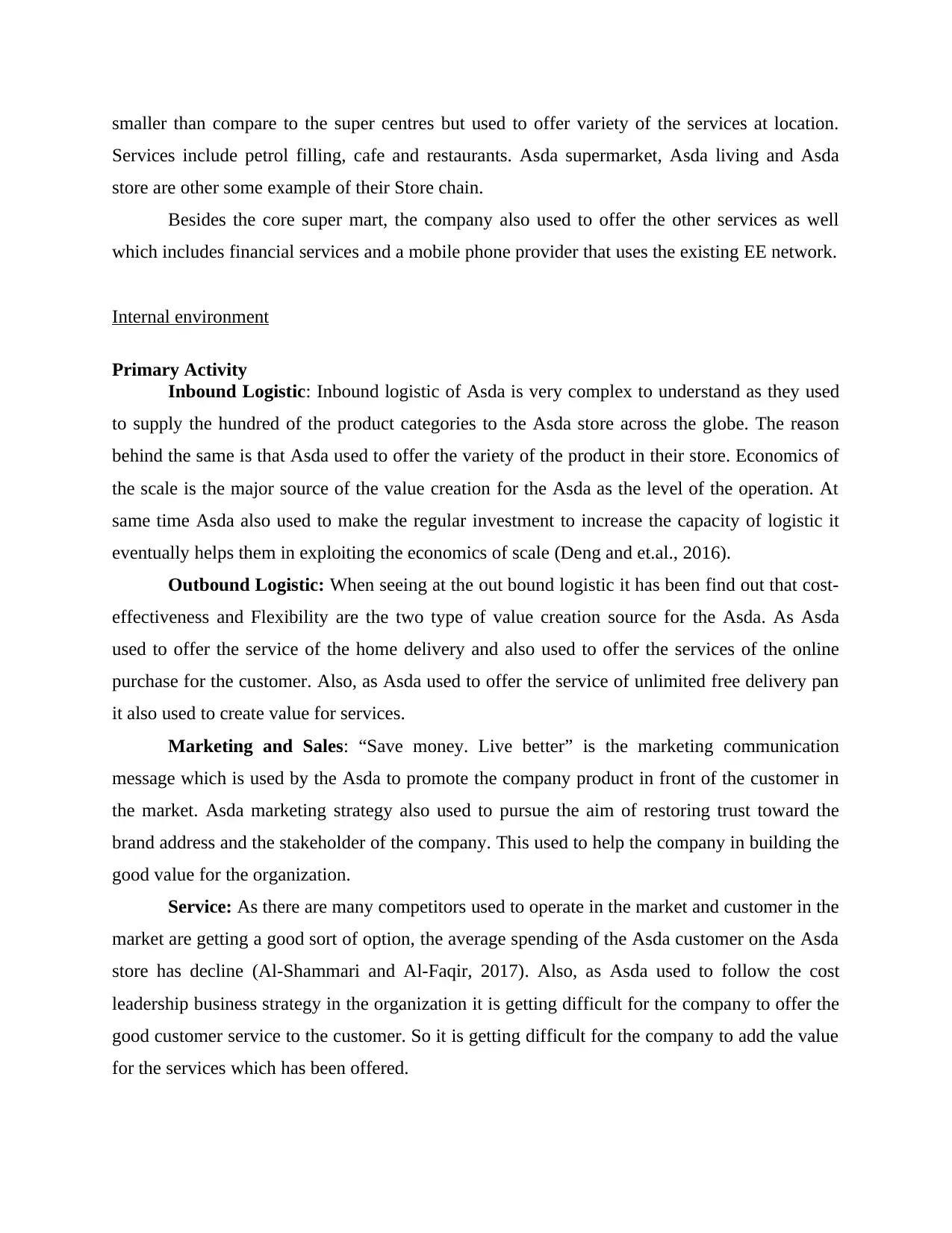
smaller than compare to the super centres but used to offer variety of the services at location.
Services include petrol filling, cafe and restaurants. Asda supermarket, Asda living and Asda
store are other some example of their Store chain.
Besides the core super mart, the company also used to offer the other services as well
which includes financial services and a mobile phone provider that uses the existing EE network.
Internal environment
Primary Activity
Inbound Logistic: Inbound logistic of Asda is very complex to understand as they used
to supply the hundred of the product categories to the Asda store across the globe. The reason
behind the same is that Asda used to offer the variety of the product in their store. Economics of
the scale is the major source of the value creation for the Asda as the level of the operation. At
same time Asda also used to make the regular investment to increase the capacity of logistic it
eventually helps them in exploiting the economics of scale (Deng and et.al., 2016).
Outbound Logistic: When seeing at the out bound logistic it has been find out that cost-
effectiveness and Flexibility are the two type of value creation source for the Asda. As Asda
used to offer the service of the home delivery and also used to offer the services of the online
purchase for the customer. Also, as Asda used to offer the service of unlimited free delivery pan
it also used to create value for services.
Marketing and Sales: “Save money. Live better” is the marketing communication
message which is used by the Asda to promote the company product in front of the customer in
the market. Asda marketing strategy also used to pursue the aim of restoring trust toward the
brand address and the stakeholder of the company. This used to help the company in building the
good value for the organization.
Service: As there are many competitors used to operate in the market and customer in the
market are getting a good sort of option, the average spending of the Asda customer on the Asda
store has decline (Al-Shammari and Al-Faqir, 2017). Also, as Asda used to follow the cost
leadership business strategy in the organization it is getting difficult for the company to offer the
good customer service to the customer. So it is getting difficult for the company to add the value
for the services which has been offered.
Services include petrol filling, cafe and restaurants. Asda supermarket, Asda living and Asda
store are other some example of their Store chain.
Besides the core super mart, the company also used to offer the other services as well
which includes financial services and a mobile phone provider that uses the existing EE network.
Internal environment
Primary Activity
Inbound Logistic: Inbound logistic of Asda is very complex to understand as they used
to supply the hundred of the product categories to the Asda store across the globe. The reason
behind the same is that Asda used to offer the variety of the product in their store. Economics of
the scale is the major source of the value creation for the Asda as the level of the operation. At
same time Asda also used to make the regular investment to increase the capacity of logistic it
eventually helps them in exploiting the economics of scale (Deng and et.al., 2016).
Outbound Logistic: When seeing at the out bound logistic it has been find out that cost-
effectiveness and Flexibility are the two type of value creation source for the Asda. As Asda
used to offer the service of the home delivery and also used to offer the services of the online
purchase for the customer. Also, as Asda used to offer the service of unlimited free delivery pan
it also used to create value for services.
Marketing and Sales: “Save money. Live better” is the marketing communication
message which is used by the Asda to promote the company product in front of the customer in
the market. Asda marketing strategy also used to pursue the aim of restoring trust toward the
brand address and the stakeholder of the company. This used to help the company in building the
good value for the organization.
Service: As there are many competitors used to operate in the market and customer in the
market are getting a good sort of option, the average spending of the Asda customer on the Asda
store has decline (Al-Shammari and Al-Faqir, 2017). Also, as Asda used to follow the cost
leadership business strategy in the organization it is getting difficult for the company to offer the
good customer service to the customer. So it is getting difficult for the company to add the value
for the services which has been offered.
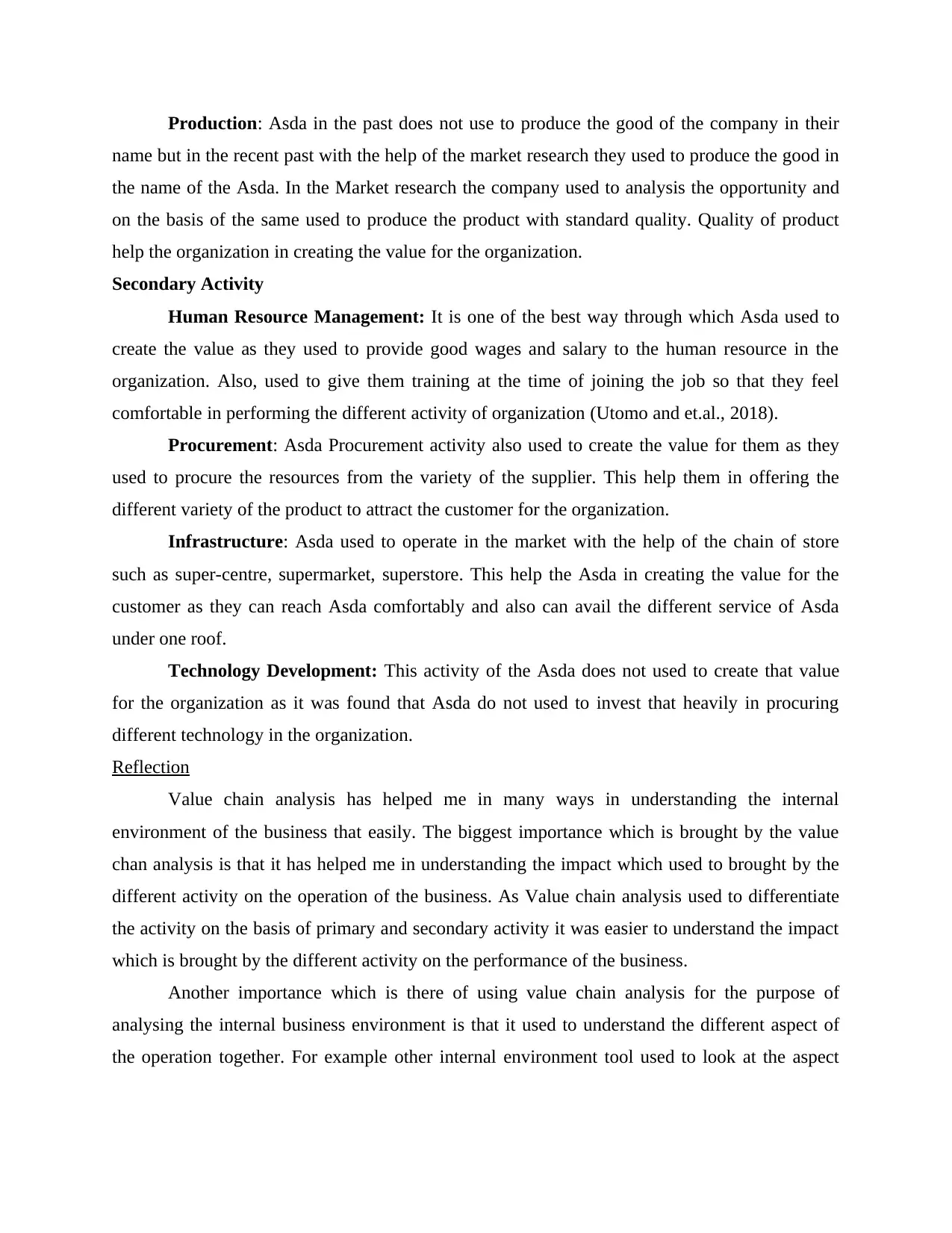
Production: Asda in the past does not use to produce the good of the company in their
name but in the recent past with the help of the market research they used to produce the good in
the name of the Asda. In the Market research the company used to analysis the opportunity and
on the basis of the same used to produce the product with standard quality. Quality of product
help the organization in creating the value for the organization.
Secondary Activity
Human Resource Management: It is one of the best way through which Asda used to
create the value as they used to provide good wages and salary to the human resource in the
organization. Also, used to give them training at the time of joining the job so that they feel
comfortable in performing the different activity of organization (Utomo and et.al., 2018).
Procurement: Asda Procurement activity also used to create the value for them as they
used to procure the resources from the variety of the supplier. This help them in offering the
different variety of the product to attract the customer for the organization.
Infrastructure: Asda used to operate in the market with the help of the chain of store
such as super-centre, supermarket, superstore. This help the Asda in creating the value for the
customer as they can reach Asda comfortably and also can avail the different service of Asda
under one roof.
Technology Development: This activity of the Asda does not used to create that value
for the organization as it was found that Asda do not used to invest that heavily in procuring
different technology in the organization.
Reflection
Value chain analysis has helped me in many ways in understanding the internal
environment of the business that easily. The biggest importance which is brought by the value
chan analysis is that it has helped me in understanding the impact which used to brought by the
different activity on the operation of the business. As Value chain analysis used to differentiate
the activity on the basis of primary and secondary activity it was easier to understand the impact
which is brought by the different activity on the performance of the business.
Another importance which is there of using value chain analysis for the purpose of
analysing the internal business environment is that it used to understand the different aspect of
the operation together. For example other internal environment tool used to look at the aspect
name but in the recent past with the help of the market research they used to produce the good in
the name of the Asda. In the Market research the company used to analysis the opportunity and
on the basis of the same used to produce the product with standard quality. Quality of product
help the organization in creating the value for the organization.
Secondary Activity
Human Resource Management: It is one of the best way through which Asda used to
create the value as they used to provide good wages and salary to the human resource in the
organization. Also, used to give them training at the time of joining the job so that they feel
comfortable in performing the different activity of organization (Utomo and et.al., 2018).
Procurement: Asda Procurement activity also used to create the value for them as they
used to procure the resources from the variety of the supplier. This help them in offering the
different variety of the product to attract the customer for the organization.
Infrastructure: Asda used to operate in the market with the help of the chain of store
such as super-centre, supermarket, superstore. This help the Asda in creating the value for the
customer as they can reach Asda comfortably and also can avail the different service of Asda
under one roof.
Technology Development: This activity of the Asda does not used to create that value
for the organization as it was found that Asda do not used to invest that heavily in procuring
different technology in the organization.
Reflection
Value chain analysis has helped me in many ways in understanding the internal
environment of the business that easily. The biggest importance which is brought by the value
chan analysis is that it has helped me in understanding the impact which used to brought by the
different activity on the operation of the business. As Value chain analysis used to differentiate
the activity on the basis of primary and secondary activity it was easier to understand the impact
which is brought by the different activity on the performance of the business.
Another importance which is there of using value chain analysis for the purpose of
analysing the internal business environment is that it used to understand the different aspect of
the operation together. For example other internal environment tool used to look at the aspect
⊘ This is a preview!⊘
Do you want full access?
Subscribe today to unlock all pages.

Trusted by 1+ million students worldwide
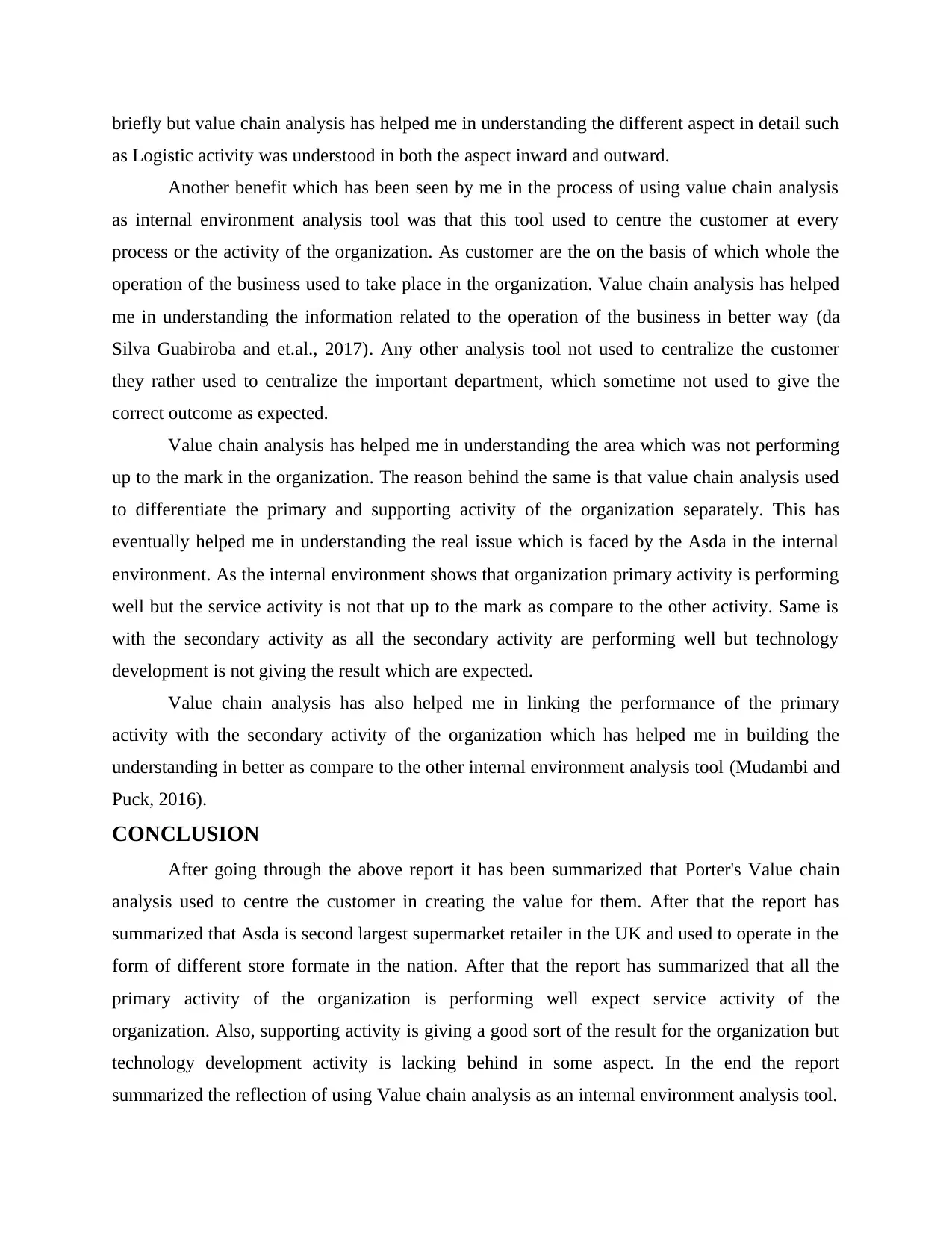
briefly but value chain analysis has helped me in understanding the different aspect in detail such
as Logistic activity was understood in both the aspect inward and outward.
Another benefit which has been seen by me in the process of using value chain analysis
as internal environment analysis tool was that this tool used to centre the customer at every
process or the activity of the organization. As customer are the on the basis of which whole the
operation of the business used to take place in the organization. Value chain analysis has helped
me in understanding the information related to the operation of the business in better way (da
Silva Guabiroba and et.al., 2017). Any other analysis tool not used to centralize the customer
they rather used to centralize the important department, which sometime not used to give the
correct outcome as expected.
Value chain analysis has helped me in understanding the area which was not performing
up to the mark in the organization. The reason behind the same is that value chain analysis used
to differentiate the primary and supporting activity of the organization separately. This has
eventually helped me in understanding the real issue which is faced by the Asda in the internal
environment. As the internal environment shows that organization primary activity is performing
well but the service activity is not that up to the mark as compare to the other activity. Same is
with the secondary activity as all the secondary activity are performing well but technology
development is not giving the result which are expected.
Value chain analysis has also helped me in linking the performance of the primary
activity with the secondary activity of the organization which has helped me in building the
understanding in better as compare to the other internal environment analysis tool (Mudambi and
Puck, 2016).
CONCLUSION
After going through the above report it has been summarized that Porter's Value chain
analysis used to centre the customer in creating the value for them. After that the report has
summarized that Asda is second largest supermarket retailer in the UK and used to operate in the
form of different store formate in the nation. After that the report has summarized that all the
primary activity of the organization is performing well expect service activity of the
organization. Also, supporting activity is giving a good sort of the result for the organization but
technology development activity is lacking behind in some aspect. In the end the report
summarized the reflection of using Value chain analysis as an internal environment analysis tool.
as Logistic activity was understood in both the aspect inward and outward.
Another benefit which has been seen by me in the process of using value chain analysis
as internal environment analysis tool was that this tool used to centre the customer at every
process or the activity of the organization. As customer are the on the basis of which whole the
operation of the business used to take place in the organization. Value chain analysis has helped
me in understanding the information related to the operation of the business in better way (da
Silva Guabiroba and et.al., 2017). Any other analysis tool not used to centralize the customer
they rather used to centralize the important department, which sometime not used to give the
correct outcome as expected.
Value chain analysis has helped me in understanding the area which was not performing
up to the mark in the organization. The reason behind the same is that value chain analysis used
to differentiate the primary and supporting activity of the organization separately. This has
eventually helped me in understanding the real issue which is faced by the Asda in the internal
environment. As the internal environment shows that organization primary activity is performing
well but the service activity is not that up to the mark as compare to the other activity. Same is
with the secondary activity as all the secondary activity are performing well but technology
development is not giving the result which are expected.
Value chain analysis has also helped me in linking the performance of the primary
activity with the secondary activity of the organization which has helped me in building the
understanding in better as compare to the other internal environment analysis tool (Mudambi and
Puck, 2016).
CONCLUSION
After going through the above report it has been summarized that Porter's Value chain
analysis used to centre the customer in creating the value for them. After that the report has
summarized that Asda is second largest supermarket retailer in the UK and used to operate in the
form of different store formate in the nation. After that the report has summarized that all the
primary activity of the organization is performing well expect service activity of the
organization. Also, supporting activity is giving a good sort of the result for the organization but
technology development activity is lacking behind in some aspect. In the end the report
summarized the reflection of using Value chain analysis as an internal environment analysis tool.
Paraphrase This Document
Need a fresh take? Get an instant paraphrase of this document with our AI Paraphraser
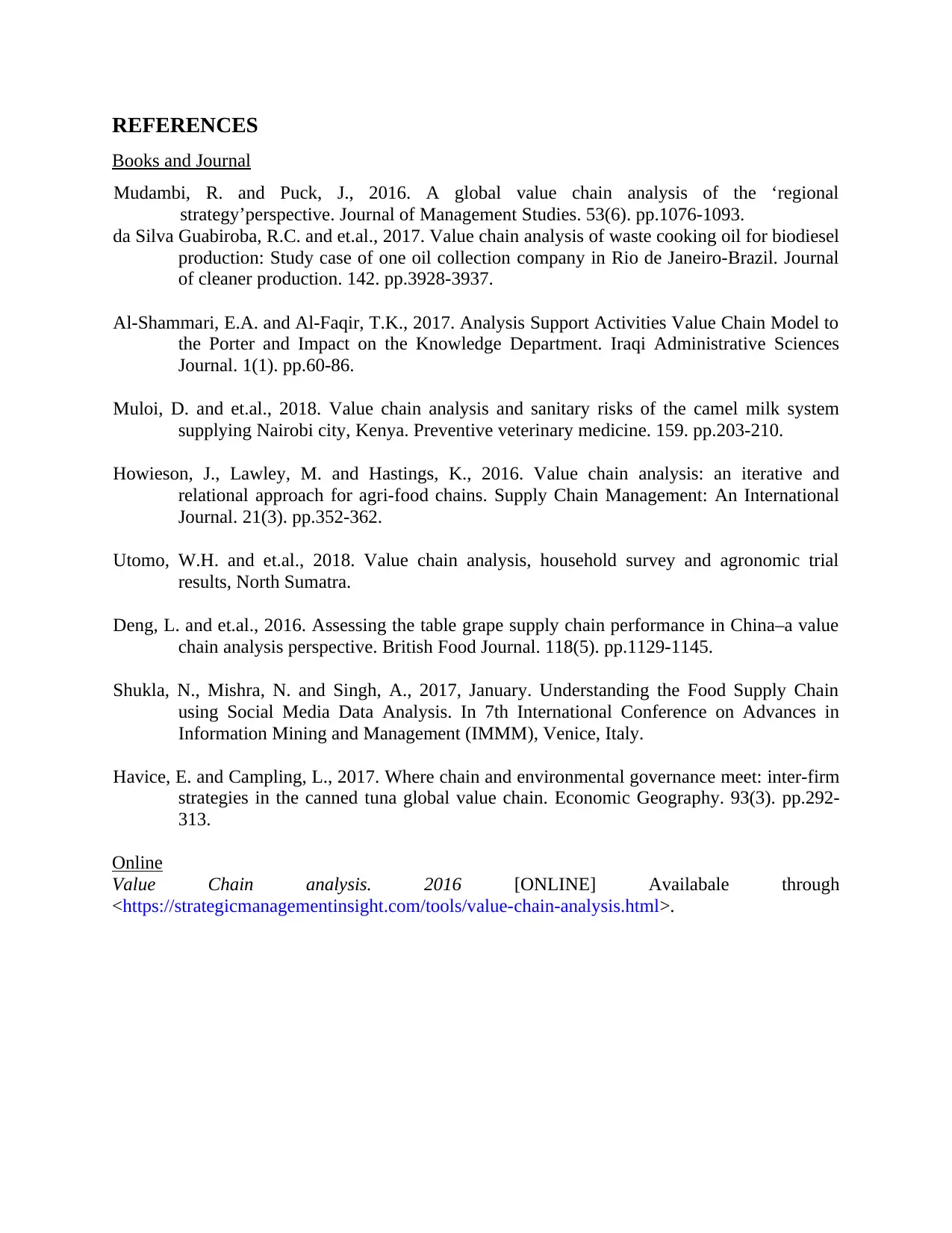
REFERENCES
Books and Journal
Mudambi, R. and Puck, J., 2016. A global value chain analysis of the ‘regional
strategy’perspective. Journal of Management Studies. 53(6). pp.1076-1093.
da Silva Guabiroba, R.C. and et.al., 2017. Value chain analysis of waste cooking oil for biodiesel
production: Study case of one oil collection company in Rio de Janeiro-Brazil. Journal
of cleaner production. 142. pp.3928-3937.
Al-Shammari, E.A. and Al-Faqir, T.K., 2017. Analysis Support Activities Value Chain Model to
the Porter and Impact on the Knowledge Department. Iraqi Administrative Sciences
Journal. 1(1). pp.60-86.
Muloi, D. and et.al., 2018. Value chain analysis and sanitary risks of the camel milk system
supplying Nairobi city, Kenya. Preventive veterinary medicine. 159. pp.203-210.
Howieson, J., Lawley, M. and Hastings, K., 2016. Value chain analysis: an iterative and
relational approach for agri-food chains. Supply Chain Management: An International
Journal. 21(3). pp.352-362.
Utomo, W.H. and et.al., 2018. Value chain analysis, household survey and agronomic trial
results, North Sumatra.
Deng, L. and et.al., 2016. Assessing the table grape supply chain performance in China–a value
chain analysis perspective. British Food Journal. 118(5). pp.1129-1145.
Shukla, N., Mishra, N. and Singh, A., 2017, January. Understanding the Food Supply Chain
using Social Media Data Analysis. In 7th International Conference on Advances in
Information Mining and Management (IMMM), Venice, Italy.
Havice, E. and Campling, L., 2017. Where chain and environmental governance meet: inter-firm
strategies in the canned tuna global value chain. Economic Geography. 93(3). pp.292-
313.
Online
Value Chain analysis. 2016 [ONLINE] Availabale through
<https://strategicmanagementinsight.com/tools/value-chain-analysis.html>.
Books and Journal
Mudambi, R. and Puck, J., 2016. A global value chain analysis of the ‘regional
strategy’perspective. Journal of Management Studies. 53(6). pp.1076-1093.
da Silva Guabiroba, R.C. and et.al., 2017. Value chain analysis of waste cooking oil for biodiesel
production: Study case of one oil collection company in Rio de Janeiro-Brazil. Journal
of cleaner production. 142. pp.3928-3937.
Al-Shammari, E.A. and Al-Faqir, T.K., 2017. Analysis Support Activities Value Chain Model to
the Porter and Impact on the Knowledge Department. Iraqi Administrative Sciences
Journal. 1(1). pp.60-86.
Muloi, D. and et.al., 2018. Value chain analysis and sanitary risks of the camel milk system
supplying Nairobi city, Kenya. Preventive veterinary medicine. 159. pp.203-210.
Howieson, J., Lawley, M. and Hastings, K., 2016. Value chain analysis: an iterative and
relational approach for agri-food chains. Supply Chain Management: An International
Journal. 21(3). pp.352-362.
Utomo, W.H. and et.al., 2018. Value chain analysis, household survey and agronomic trial
results, North Sumatra.
Deng, L. and et.al., 2016. Assessing the table grape supply chain performance in China–a value
chain analysis perspective. British Food Journal. 118(5). pp.1129-1145.
Shukla, N., Mishra, N. and Singh, A., 2017, January. Understanding the Food Supply Chain
using Social Media Data Analysis. In 7th International Conference on Advances in
Information Mining and Management (IMMM), Venice, Italy.
Havice, E. and Campling, L., 2017. Where chain and environmental governance meet: inter-firm
strategies in the canned tuna global value chain. Economic Geography. 93(3). pp.292-
313.
Online
Value Chain analysis. 2016 [ONLINE] Availabale through
<https://strategicmanagementinsight.com/tools/value-chain-analysis.html>.
1 out of 8
Related Documents
Your All-in-One AI-Powered Toolkit for Academic Success.
+13062052269
info@desklib.com
Available 24*7 on WhatsApp / Email
![[object Object]](/_next/static/media/star-bottom.7253800d.svg)
Unlock your academic potential
Copyright © 2020–2025 A2Z Services. All Rights Reserved. Developed and managed by ZUCOL.





